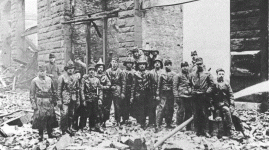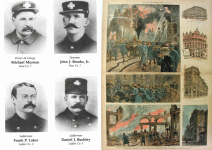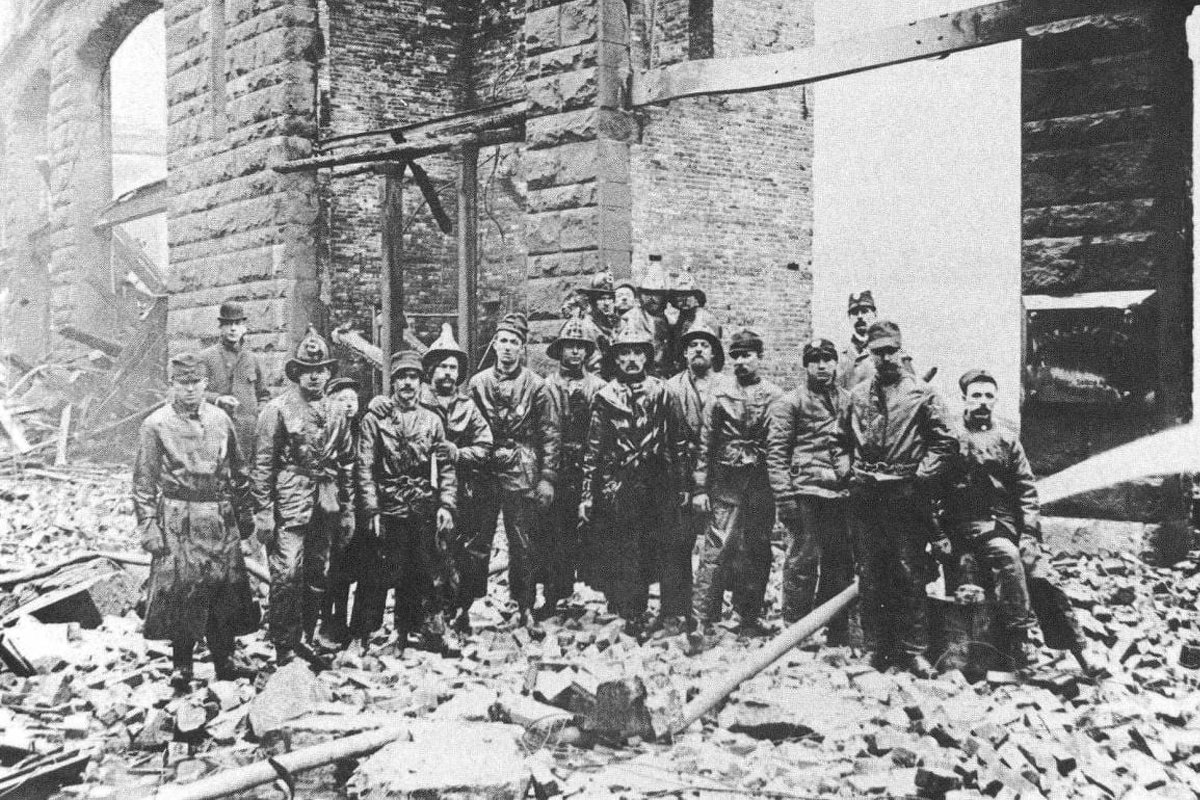THE MASSIVE THANKSGIVING DAY FIRE OF 1889 THAT KILLED 5 BOSTON FIREFIGHTERS
November 24, 2021 ·
Matt Fratus

A six-story building on the corner of
Kingston and Bedford, located in the heart of Boston’s downtown neighborhood, erupted in a massive four-alarm fire on Thanksgiving Day, 1889. The blaze spread to adjacent buildings situated along the city block. While emergency responders worked to knock down the flames, five
Boston firefighters lost their lives, and Boston suffered nearly
$4 million ($120 million today) worth of
property damages.
The month of November is considered the cruelest month to the Boston Fire Department.
Box 52 sounded an alarm at 8 a.m. that rainy Thanksgiving morning, giving a signal to the firefighters to respond. That box has a history among the city’s famous and out-of-control fires. It was the same
fire box to alert firefighters during the
Great Boston Fire of 1872, when 776 buildings burned to the ground, 65 acres of land were left in ruins, and the cost of the
property losses neared $75 million, or $1.7 billion today.
“The Boston Fire Department became a great firefighting force unfortunately through necessity,” former Boston fire Commissioner
Paul Christian said in 2012. “The old town of Boston was built of wood. The original chimneys were built of wood. It was a very combustible city.”

Four of the five Boston firefighters killed during the Thanksgiving Day Fire of 1889, left. Missing is retired Boston firefighter Hoseman Edward E. Whiting, who was hurt in the collapse and succumbed to his injuries days later. On the right, a Gleason’s Pictorial immortalized the now-famous fire in Boston’s history. Composite by Coffee or Die Magazine.
The weather on the night before the now-infamous Thanksgiving Day Fire of 1889 has inspired at least one theory regarding the spark behind the blaze.
“If you look back at old photographs of Boston and New York in the 1870s and 1880s, you’ll notice there were a lot of telegraph wires all over the place,” Christian, a 38-year veteran of the Boston Fire Department, said. “Back then, the telegraph was a principal means of communication.”
The fire alarm systems were on those telegraph lines. In those days, some companies also sold “time.” A Boston time company regularly issued a timeout over the circuits to keep all the clocks of companies and businesses on the accurate time. The pouring rain on the eve of Thanksgiving created problems in the circuits. Christian believed an electrical fire caused the blaze.
When the first fire apparatus arrived on the scene, thick black smoke was billowing out of the sixth-floor windows. The fire jumped across the street and into the Ames Building. Firefighters from Hose Company 7 and Ladder Company 3 raced into the Ames Building to stop the fire’s spread. The structural properties of the building gave way, and the walls collapsed, killing five.
The dead included: hoseman John J. Brooks Jr., 29, Hose Company 7; hoseman Michael Murnan, 34, Hose Company 7; ladderman Daniel J. Buckley, 31, Ladder Company 3; ladderman Frank P. Loker, 33, Ladder Company 3; and hoseman Edward E. Whiting, a retired member of the BFD.
In addition to the fallen firefighters, the collapse destroyed several firefighting apparatuses, including the steamer of Engine Company 26 and an aerial truck of Ladder Company 13. A
water tower — an early predecessor to firefighting apparatuses that shoot a stream of water into upper floors of buildings — was also destroyed. The steamer of Engine Company 22 survived the falling debris; however, it suffered damages, too.
“I am confident that Thursday’s fire had been burning for a long time before it was discovered,” a
BFD investigator assigned to the case recalled. “If a watchman had been on hand to ring in an alarm as soon as the fire started, I am confident that Chief [Louis] Webber and his men could never have allowed the fire to spread beyond the building.”
Boston suffered yet another tragedy on Thanksgiving Day in 1942 when the
Cocoanut Grove Fire took the lives of more than 490 people. Reports determined all who were killed died in the initial 15 minutes of the inferno.
A six-story building on the corner of Kingston and Bedford, located in the heart of Boston’s downtown neighborhood, erupted in a massive four-alarm fire on Thanksgiving Day, 1889. The blaze spread to adjacent buildings situated along the city block.

www.coffeeordie.com




